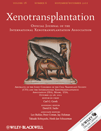Thrombocytopenia after pig-to-baboon liver xenotransplantation: where do platelets go?
Abstract
Ezzelarab M, Ekser B, Gridelli B, Iwase H, Ayares D, Cooper DKC. Thrombocytopenia after pig-to-baboon liver xenotransplantation: where do platelets go? Xenotransplantation 2011; 18: 320–327. © 2011 John Wiley & Sons A/S.
Abstract:
Background: In baboons with orthotopic pig liver xenografts, profound thrombocytopenia was observed within 1 h after reperfusion. Assessment of the fate of platelets may shed light on the underlying mechanisms leading to thrombocytopenia and may allow preventive therapies to be introduced.
Methods: Platelet–white blood cell (WBC) aggregation was studied in two baboons that received orthotopic liver xenografts from α1,3-galactosyltransferase gene-knockout pigs transgenic for human CD46 (GTKO/CD46). Percentages of CD42a-positive platelet aggregates with WBC-subtypes were determined by flow cytometry, and absolute numbers (per mm3) were calculated. Platelet aggregates in the liver xenografts were identified by immunofluorescence and electron microscopy. Mean platelet volume (MPV) was determined before and after transplantation.
Results: After pig liver reperfusion, profound thrombocytopenia was associated with aggregation of platelets with WBC-subtypes. Increasing aggregation of platelets with WBC-subtypes was detected throughout the post-transplant period until the recipient was euthanized. Significant negative correlation was found between platelet counts in the blood and aggregation of platelets with monocytes (P < 0.01) and neutrophils (P < 0.01), but not with lymphocytes. MPV remained within the normal range. Two hours after reperfusion, platelet and fibrin deposition were already detected in the liver xenografts by immunofluorescence and by electron microscopy.
Conclusions: Following liver xenotransplantation, the early disappearance of platelets from the circulation was at least in part due to their aggregation with circulating WBC, which may augment their deposition in the liver xenograft and native lungs. Prevention of platelet aggregation with monocytes and neutrophils is likely beneficial in reducing their subsequent sequestration in the liver xenograft and native organs.




